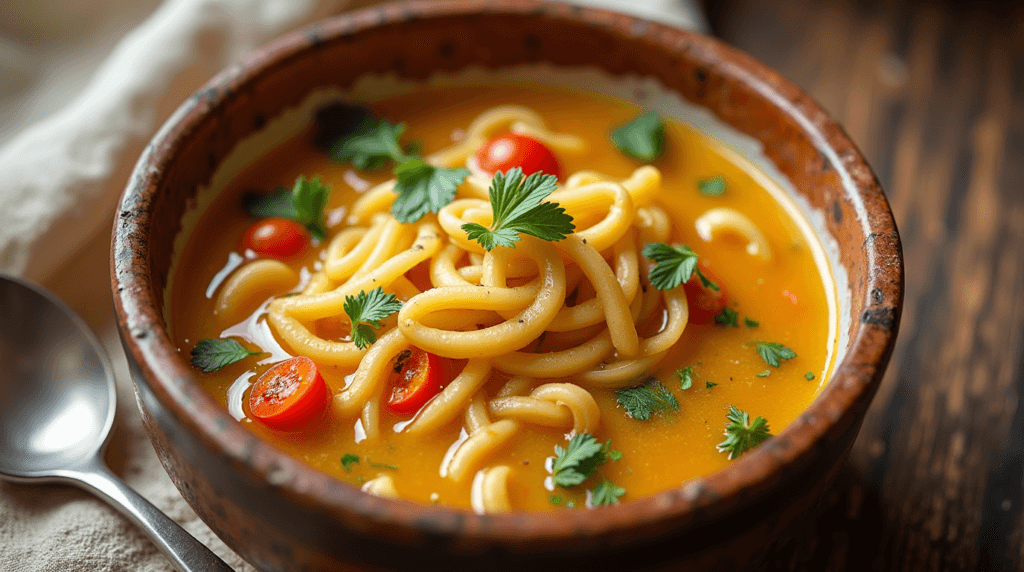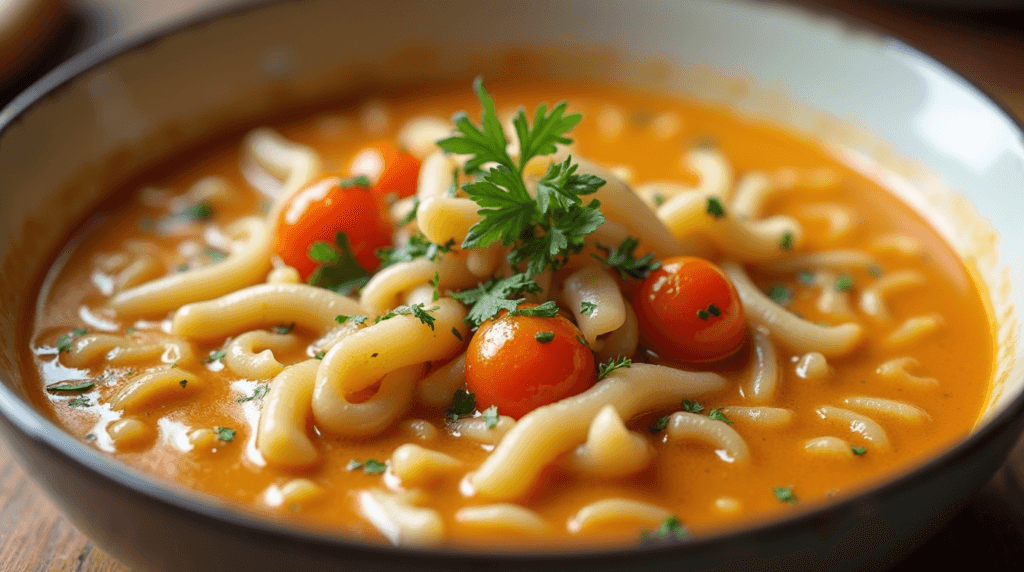Pastina Soup Recipe: The Best Italian Nourishing -100% Classic-
Why Pastina Soup Is the Ultimate Comfort Food
Ever wondered why pastina soup, a beloved Italian dish, is so comforting? It’s not just the warm broth, the tiny pasta, and the savory flavors. Pastina soup’s charm comes from its simplicity, its rich tradition, and the love with which it’s made. This guide will explore the secrets of pastina and why it has captured hearts around the world.
What makes pastina special? Is it the soothing warmth, the tiny pasta that melts in your mouth, or the nostalgic connection it fosters with childhood memories? By exploring its history, ingredients, and variations, you’ll understand why pastina is loved as a classic comfort food in Italian kitchens and beyond.
Table of Contents
The History and Origins of Pastina Soup
Pastina, meaning “little pasta” in Italian, is a type of tiny pasta often used in soups or served as a side dish. While pastina itself has been around for centuries, the tradition of making pastina soup has its roots in Italian home kitchens, where it has been passed down as a nourishing and comforting meal.
The dish is often associated with childhood, as it is a staple for children in Italy, especially when they’re under the weather or in need of a light meal. Though it may seem simple, the history of pastina soup reflects Italy’s deep culinary traditions of creating nourishing meals from humble ingredients.

Key Ingredients in a Traditional Pastina Soup
At its heart, pastina soup is made from just a few basic ingredients. But like many Italian dishes, the quality of each ingredient makes all the difference. These are the essential components of a classic pastina soup:
- Pastina (Little Pasta): The star of the dish. These tiny pasta shapes, such as stars, alphabets, or small pellets, are what make the soup comforting and easy to digest.
- Broth: The base of Pastina can vary, but it’s typically made from chicken or vegetable broth. It should be flavorful but light, serving as the perfect backdrop for the delicate pastina.
- Seasonings: Salt, pepper, and sometimes a hint of garlic or onion are used to season the broth. Fresh herbs, such as parsley, are often added at the end to elevate the flavor.
- Cheese: A generous sprinkle of grated Parmesan or Pecorino Romano is often added to give the soup a rich, savory finish.
The Broth: The Heart of Pastina Soup
The broth in Pastina is what gives it its soul. While the broth can be simple, it’s crucial that it’s made with care, allowing the flavors to develop fully.
- Chicken Broth: The most common base for pastina soup, chicken broth provides a rich, comforting foundation. A well-made chicken broth is often simmered for hours with vegetables, herbs, and spices to bring out a deep, savory flavor.
- Vegetable Broth: For a lighter option, vegetable broth is a perfect substitute. It’s ideal for those looking for a vegetarian alternative but still provides a satisfying base for the soup.
The key is to keep the broth clean, light, and balanced so the pastina can shine without being overwhelmed by the liquid.
Classic Pastina Soup Recipe
Making Pastina at home is simple, and the recipe can be easily adapted to your preferences. Here’s a basic guide to creating this comforting dish:
Ingredients:
- 4 cups chicken or vegetable broth
- 1 cup pastina (small pasta like stars, orzo, or acini di pepe)
- Salt and pepper, to taste
- 1-2 tablespoons olive oil or butter
- Fresh herbs (parsley or basil), finely chopped
- 1/4 cup grated Parmesan or Pecorino Romano (optional)
Instructions:
- Prepare the Broth: In a large pot, heat the chicken or vegetable broth over medium heat until it reaches a gentle simmer. Season with a pinch of salt and a few cracks of black pepper.
- Cook the Pastina: Add the pastina to the simmering broth and cook according to the package instructions, usually around 6-8 minutes, until the pasta is tender but not overcooked. Stir occasionally to prevent the pasta from sticking.
- Finishing Touches: Once the pastina is cooked, stir in a tablespoon of olive oil or butter to add richness to the soup. Taste and adjust seasoning if needed.
- Serve: Ladle the soup into bowls, and garnish with a sprinkle of grated Parmesan or Pecorino Romano and fresh herbs.
Optional Add-Ins: You can also add a soft-boiled egg for extra richness, or a handful of spinach or peas for added texture and flavor.

Toppings and Garnishes: The Finishing Touch
While pastina soup is delicious on its own, the right toppings can elevate the dish:
- Cheese: Grated Parmesan or Pecorino Romano adds a creamy, salty kick.
- Herbs: Fresh parsley, basil, or thyme bring freshness and a pop of color.
- Olive Oil: A drizzle of high-quality olive oil can add richness to the broth.
- Egg: A soft-boiled egg with a runny yolk is a common addition, especially in Southern Italy.
- Croutons or Bread: A slice of toasted bread, rubbed with garlic, can be a great accompaniment.
Regional Variations of Pastina Soup
While the basic recipe is simple, pastina soup has a few regional variations across Italy.
- Neapolitan Pastina: In Naples, pastina soup is often served with a poached egg, adding a creamy texture and richness to the broth.
- Pastina Alla Romana: In Rome, pastina may be cooked with a touch of butter, grated Parmigiano, and a sprinkle of nutmeg, which adds an aromatic twist.
- Sicilian Pastina: In Sicily, pastina is often cooked with a tomato-based broth and served with a dollop of ricotta on top for a creamy finish.
Each variation highlights the regional tastes and traditions of Italy, showing how a simple dish can be transformed with local ingredients.
Making Pastina Soup at Home: Essential Techniques
Making pastina soup at home is easy, but a few tips can make a big difference in the final result:
- Broth Quality: Always use a high-quality broth, homemade if possible. It’s the foundation of the soup and will make a noticeable difference in flavor.
- Cooking the Pastina: Be careful not to overcook the pastina. It can quickly become mushy in the broth, so aim for al dente pasta.
- Herb Infusion: For extra depth, consider infusing your broth with a sprig of rosemary or thyme while it simmers. Just remove the herbs before serving.
- Make-Ahead: Pastina soup is a great dish to make in bulk. You can store leftover broth separately from the pasta, as the pasta can absorb too much liquid if stored together.
From Simple to Gourmet: Modern Takes on Pastina Soup
Pastina soup is beloved for its simplicity, but modern chefs and home cooks alike have found creative ways to elevate this classic dish. You might see versions with:
- Truffle oil for a touch of luxury
- Lemon zest or a squeeze of fresh lemon juice to brighten the flavors
- Gourmet cheeses like burrata or fresh mozzarella for added richness
- Roasted vegetables such as carrots, celery, or tomatoes, added directly to the broth
These twists transform a simple soup into something extraordinary, perfect for serving as a refined starter or a cozy main dish.
FAQ:
What is pastina soup?
Pastina soup is a comforting Italian dish made with tiny pasta and a flavorful broth, often served to children or those feeling under the weather. It’s a light, nourishing dish that can be customized with various seasonings and toppings.
How can I make pastina soup more filling?
You can make pastina soup more filling by adding vegetables, beans, or a poached egg. A slice of toasted bread or a sprinkle of cheese also adds heartiness to the soup.
What are some common variations of pastina soup?
Common variations include pastina with a poached egg (Neapolitan style), pastina with tomato-based broth (Sicilian style), and pastina with butter and nutmeg (Roman style).
Can I make pastina soup ahead of time?
Yes! You can prepare the broth ahead of time and store it in the refrigerator. Cook the pastina just before serving to prevent it from becoming too soft.

